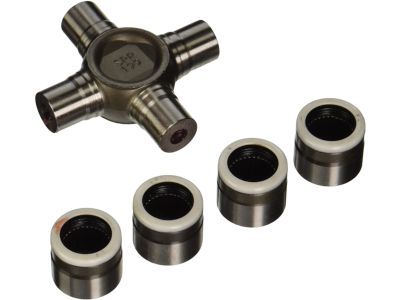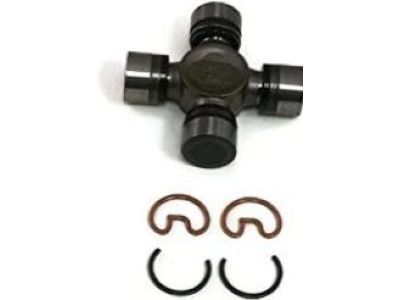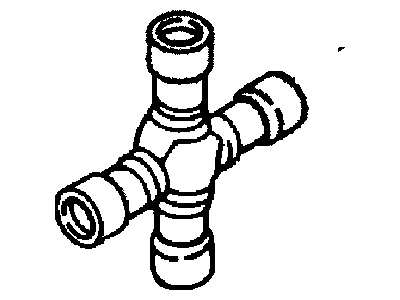My Garage
My Account
Cart
Genuine Chevrolet K1500 Universal Joint
U-Joint- Select Vehicle by Model
- Select Vehicle by VIN
Select Vehicle by Model
orMake
Model
Year
Select Vehicle by VIN
For the most accurate results, select vehicle by your VIN (Vehicle Identification Number).
6 Universal Joints found
Chevrolet K1500 Joint Kit, Front Axle Propeller Shaft Front Universal
Part Number: 23104840$53.07 MSRP: $87.24You Save: $34.17 (40%)Ships in 1-2 Business DaysChevrolet K1500 Joint Kit,Front Axle Propeller Shaft Universal
Part Number: 89059111$155.48 MSRP: $270.61You Save: $115.13 (43%)Ships in 1-2 Business DaysChevrolet K1500 Joint Kit,Propeller Shaft Rear Universal
Part Number: 89040245$96.28 MSRP: $167.55You Save: $71.27 (43%)Ships in 1-2 Business DaysChevrolet K1500 Joint Kit,Propeller Shaft Front Universal
Part Number: 89040243$72.78 MSRP: $183.13You Save: $110.35 (61%)Ships in 1-2 Business DaysChevrolet K1500 Joint Kit,Propeller Shaft
Part Number: 12545628$42.55 MSRP: $85.80You Save: $43.25 (51%)Ships in 1-2 Business Days
Chevrolet K1500 Universal Joint
The Universal Joint is installed in Chevrolet K1500 vehicles to connect the driveshaft to the differential; this moves as the suspension of the car needs to since the road surface. This joint is to allow the driveshaft to rotate in a way that it will adapt the changes in angle between the components. Ordinarily, a Universal Joint comprises of a cross with needle bearings and these are fitted in hardened steel cups which are held in position by clips. K1500 vehicles, for many years, have had both the factory pre-lubricated U Joints and choices with provision for grease zerks. Worn U Joints present many symptoms, from noticeable rattle and clunking when shifting gears to violent vibrations at speed, and therefore require inspection or replacement. Lubricant conditions indicate wear and are usually marked by cracked seals or the absence of clips, and they should be checked often for the proper functioning of the equipment.
Each OEM Chevrolet K1500 Universal Joint we offer is competitively priced and comes with the assurance of the manufacturer's warranty for the part. Furthermore, we guarantee the speedy delivery of your orders right to your doorstep. Our hassle-free return policy is also in place for your peace of mind.
Chevrolet K1500 Universal Joint Parts Questions & Experts Answers
- Q: How to universal joint replacement on Chevrolet K1500?A: Before beginning the universal joint replacement procedure, it's crucial to have a universal joint service kit specific to your vehicle. First, remove the driveshaft. For the outer snap-ring type universal joint, place the driveshaft on a bench equipped with a vise. Remove the snap-rings using small pliers, then support the cross (also called a spider or trunnion) on a short piece of pipe or a large socket and use another socket to press out the cross by closing the vise. Press the cross through as far as possible, grip the bearing cup with locking pliers, and remove it. A universal joint repair kit will provide new components like a trunnion, seals, bearings, cups, and snap-rings. Inspect the bearing cup housing in the driveshaft for wear and damage; if it's too worn, the driveshaft will require replacement. Ensure the dust seals are correctly positioned on the trunnion. Using a vise, press one bearing cup into the yoke about 1/4-inch, use grease to keep the needle rollers in place, insert the trunnion into the partially installed bearing cup, insert the needle bearings into the opposite cup, and press both cups into place using a slightly smaller socket. Install the snap-rings to secure the cups. For the injected plastic (inner snap-ring) type, if the joint has been previously rebuilt, remove the snap-rings located on the inner part of each bearing cup. For first-time rebuilding, it won't be necessary to remove the snap-rings; the pressing operation will shear the molded plastic retaining material. Press out the bearing cups, remove the trunnion (cross), and clean all plastic material from the yoke. Reassembly is similar to the outer snap-ring joint, but the snap-rings are on the inner part of each bearing cup. When installing the bearing cup, press it in until the snap-ring can be installed, and if needed, strike the yoke with a hammer to allow the snap-ring groove to move into position.
- Q: What is a driveshaft and universal joints and its function on Chevrolet K1500?A: A drive shaft is a tube or set of tubes that transfers power between either the transmission or the transfer case on 4WD models and the differential. Universal joints are positioned at each end of the driveshaft as well as in the center of two-piece driveshafts. On 2WD models, their driveshafts have a front splined yoke that slips into the transmission extension housing so that their length can increase and decrease. An oil seal prevents leakage at this point. Driveshafts on 4WD models tend to come with a splined yoke / companion flange at the transfer case end while two-piece driveshafts typically sport a slip joint at the front of the rear section. Center bearings carry the driveline when two-piece driveshafts are used. It's not often you need to service a drive shaft assembly but if anything goes wrong, replace worn universal joints since they have had to be greased for life. The drivshaft must be cleaned and checked for damage whenever lifting vehciles during servicing, ensuring that small weights used in balancing it do not detach. In most instances, noise or vibration when driving signifies trouble in the drivshaft whereas road testing can clarify whether this is right.



















